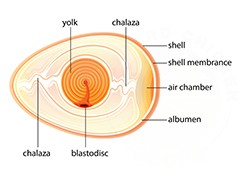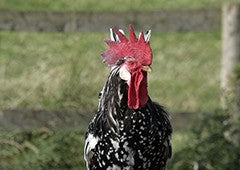Many mixed poultry enthusiasts often find themselves stumped around egg collection time. Who laid what egg? One is a dark olive colour - could that be Lucy Goosey? This egg has brown spots all over it! Maybe that’s from Quack the Duck? Or Penny the hen? Whose are whose?!
Well, here’s your guide to what the bum nuts from different poultry look like, the goodness they contain and what their described tastes are!
Chicken Eggs
We all know what chicken eggs look and taste like but here's a refresher!
- Chicken egg colours and sizes depend on the breed of chicken that has laid them.
- They are comprised of a yellow yolk and a white ‘albumen’.
- They are a great source of protein, which is egg-cellent for muscle development.
- They are a versatile ingredient - use them in baking, make delicious frittatas or just eat them by themselves!
Check out our ‘Everything You Need To Know About Eggs’ article for more information on everyone's favourite breakfast food!
Duck Eggs
Duck eggs have higher nutrient levels than chicken eggs, however their cholesterol level is also higher. They are generally regarded as better for you, but aren’t as widely available as chicken eggs are.
What they look like:
Vary in size and colour according to breed - generally they are large, white/cream coloured oval shapes.
- The egg and yolk is larger than that of a chicken's.
- The average egg weighs approximately 50 grams.
- Duck eggs have a higher protein, vitamin, mineral and fat content.
- Stay fresher for longer than chickens'.
- Duck eggs are said to be more flavoursome than that of chickens.
Quail Eggs
Quail eggs are small but boy, do they pack some nutritional goodness! They have far higher nutrient levels than that of chickens, and are an amazing source of Iron.
What they look like:
Small with brown spots dotted around the shell.
- Small in comparison to other poultry eggs - around the size of a grape! Generally, about 5-6 quail eggs equals 1 normal chicken egg. This also means they are much faster to cook.
- Packed with Iron, Potassium, Vitamins and Minerals- more so than chicken eggs.
- The taste is described as very similar to chicken eggs - most people can’t tell the difference.
Goose Eggs
Eggs from Geese are fairly easily identified - they dwarf any other kind of poultry egg in size!
- A standard goose egg is about three times bigger than your average chicken egg.
- Due to its size, its vitamin levels are higher- therefore it has a significantly larger amount of Phosphorous, Calcium, Iron, Potassium, Zinc and Protein.
- Are described as having a much richer taste than chicken eggs.
- Can be cooked in any of the same ways that chicken eggs can, but will take longer. If frying, the egg should be cooked at a lower temperature so the white does not burn while the yolk is cooking.
- Avid bakers have mentioned that goose eggs are great for their cakes, slices and other baked goods!
Pheasant Eggs
Pheasant eggs are also a popular alternative to the standard chicken egg. Despite their dark olive shells, the eggs inside look the same - with the taste being similar but slightly richer.
- Are a smooth olive colour.
- They are approximately the size of a small chicken egg.
- Have a larger proportion of yolk to white- the yolk is described as having a richer taste than that of chickens.
Guinea Fowl Eggs
Guinea Fowls are becoming increasingly popular in mixed backyard flocks. Guineas are hardier creatures than chickens and lay eggs through conditions that chickens may not - such as hotter weather.
- Guinea Fowl eggs are a creamy colour with light brown spots. The small end are more pointed than the chicken egg.
- They have a higher yolk to white ratio than normal chicken eggs.
- Guinea fowl eggs are smaller than chickens' - the general rule is that 2 guinea fowl eggs equals 1 large chicken egg.
- The shell is harder than that of a chicken egg - more force is required to crack them open!
- The taste is regarded as virtually identical to chicken eggs.
Chickens eggs are of course the most easily available - plus no matter how many we eat, we never seem to get sick of their wholesome taste!
If you have a mixed poultry flock that produces eggs of all shapes and sizes, post the photos on our Facebook page!
Finding the best chicken breeds to thrive with other poultry can be eggtremely confusing and difficult. For the perfect match, you may consider their traits, personality and egg-laying talents - so, where should you begin?
Cluckily, our friends over at Chickenpedia have created an amazing Chicken Breeds Course. This extensive online course shares useful advice on choosing the right chickens for you as well as size & frequency of eggs laid. You’ll even learn about their individual personalities, and be able to use their family-friendly compatibility scale through this well-structured program. It really is a great way to find your perfect backyard buddies which is why I highly recommend them to all of my readers! The courses are beginner-friendly and filled with vital information to help you raise a happy, healthy flock.
As chicken keepers, we want to do an eggcellent job when caring for our feathered friends, but many of us struggle to handle chicken health or behavior issues, especially in the first few years of having a flock. Chickenpedia have a full range of comprehensive online courses that cover everything you didn’t know you need to know and then some more! From healthcare to raising baby chicks to feeding and behavior, that’ll give you the knowledge and confidence to successfully look after your chickens.
As a member, you will get access to ALL their fantastic courses. So, no need to wing it, become a confident chicken keeper. Click here to check out Chickenpedia today!
Many of our poultry enthusiasts use our coops for a variety of feathered friends! Ducks, Quails, Guinea Fowls and more have made their home in the Taj Mahal, Penthouse or Mansion. However, keep in mind that some of these kinds of poultry are bigger than your average chicken - so the recommended 2-10 or 2-20 hens will probably need to be less for ducks!


















